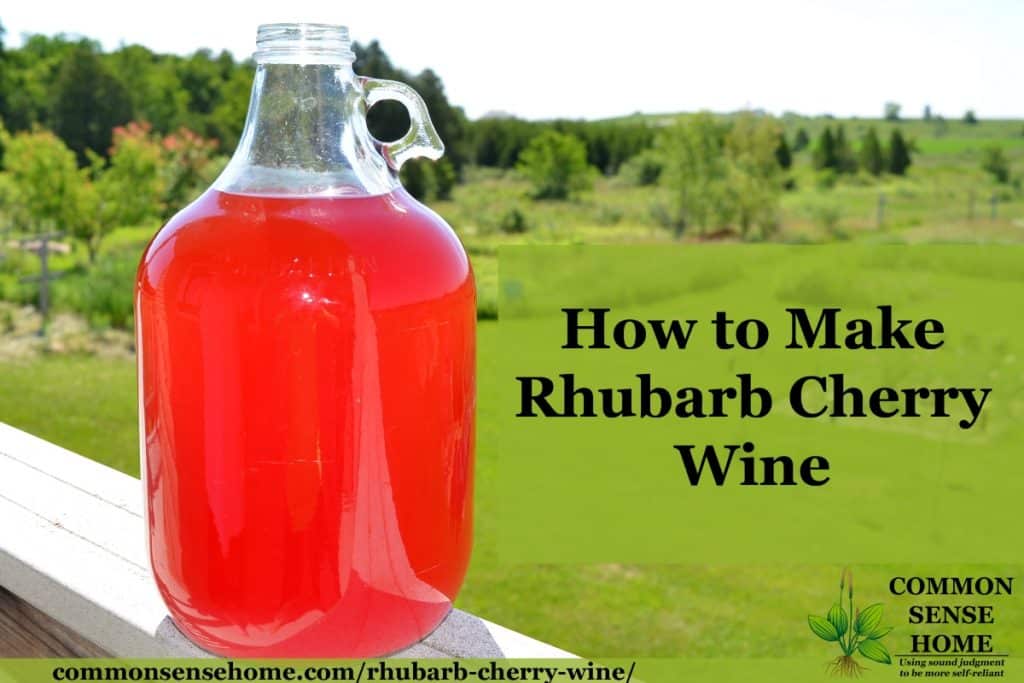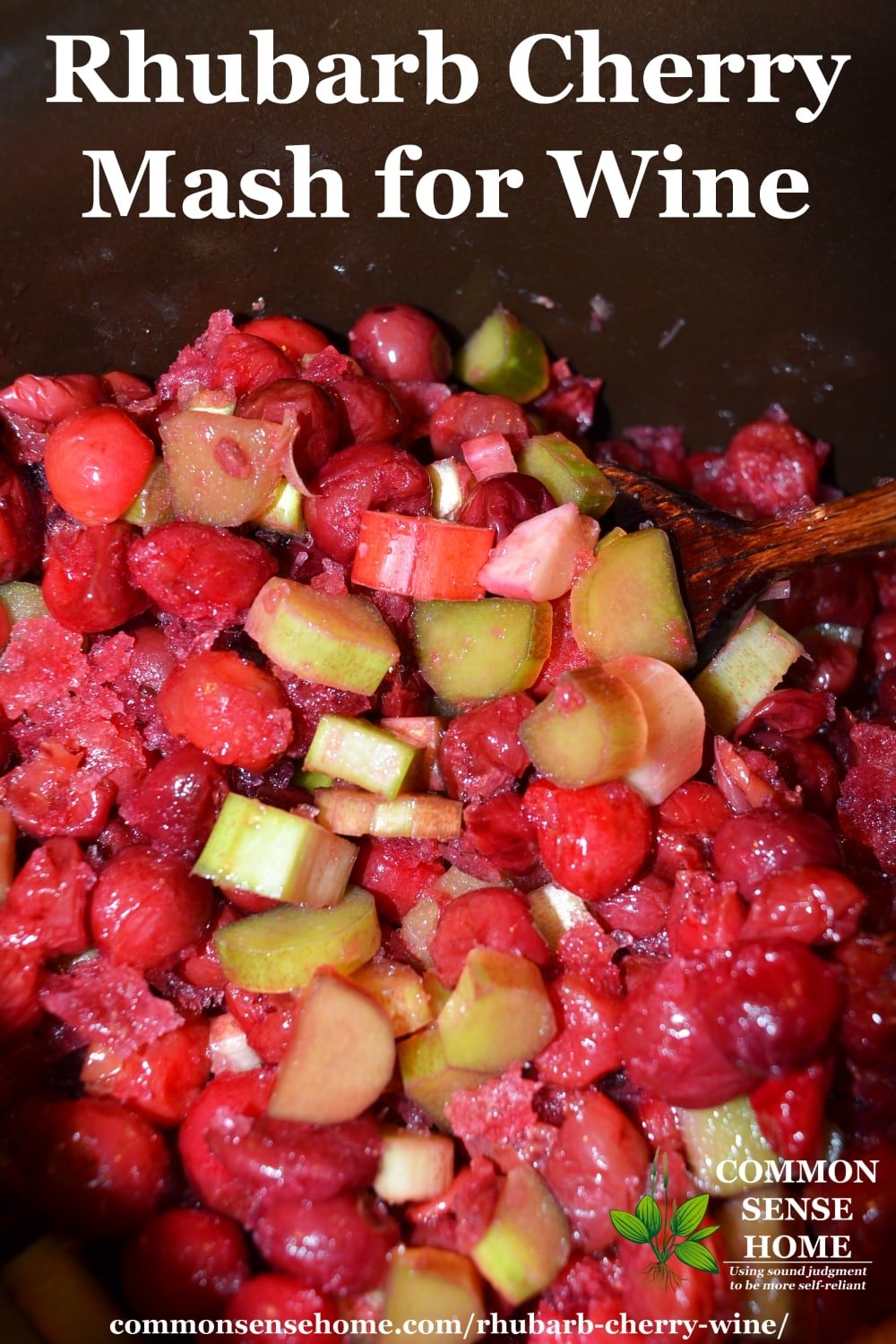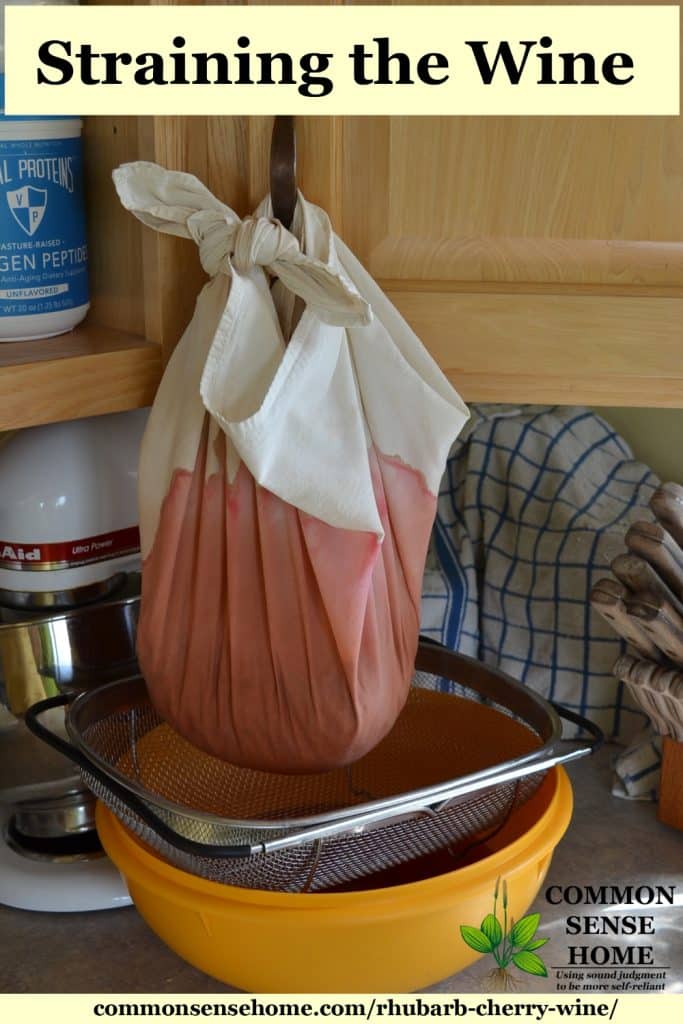Rhubarb Cherry Wine – A Fun Twist on Rhubarb Wine
This post may contain affiliate links. Read my full disclosure here.
When rhubarb is abundant, I like to use it in recipes like rhubarb pudding cake and rhubarbade, but I hadn’t tackled rhubarb wine. When looking through my favorite old school winemaking book, I came across a rhubarb cherry wine recipe that looked like a perfect combination to use the rhubarb harvest and the stash of Door County cherries in my freezer. (You could use canned cherries, but the color won’t be as bright.) I think it’s fun to add some color to a basic rhubarb wine recipe, too.

If you’d like to give an easy homemade wine a try, this recipe is for you. (Look here for rhubarb growing tips.)
Rhubarb Cherry Wine Recipe
Ingredients
- 4 quarts rhubarb, cut into 1/2″ pieces
- 3 quarts of tart red cherries, fresh or frozen
- 4 quarts of water
- 8 cups of cane sugar
- 1 package of wine yeast
Directions
Combine chopped rhubarb and stemmed cherries in a crock or large non-reactive kettle. (Minimum 3 gallon capacity recommended.) Note: If using frozen cherries, partially thaw and combine with rhubarb immediately for best color. Do not allow to thaw completely and sit around, or they will oxidize and the color will fade.

Add 4 quarts of water, cover with a flour sack towel to keep bugs out and put in a warm location to ferment for two weeks. Stir daily, crushing fruit against sides of crock. If you don’t use pitted cherries, don’t crush the pits while brewing. They would make the wine bitter. During this time, the wine may develop a white layer of bloom from the natural yeasts in the fruit. This is nothing to be worried about. You can skim it or stir it in.

At the end of two weeks, strain fruit mash through a jelly bag or flour sack towel. Squeeze until very dry. Return liquid to crock and stir in the sugar, making sure it has dissolved completely. Dissolve wine yeast per package directions, stir into sweetened juice mix.
Would you like to save this?
Cover and ferment for 2 more weeks, stirring twice each week.
After the end of the second two weeks, strain through several layers of cheesecloth or a flour sack towel. Juice mix will likely be very cloudy and yeasty, so you should return it to the crock, a carboy or 2 gallon jugs and allow it to settle for 2-5 days.

When the wine has settled, siphon into clean, sterilized bottles and cork lightly (or cover with balloons). When you are sure fermenting has ceased, cork tightly. Store for at least one year before drinking.
Note: Cane sugar is preferred over beet sugar because it does ferment differently. Given that can sugar producers have started using glyphosate at harvest time to promote more even die down and increase yields, I buy organic cane sugar in bulk to avoid RoundUp™ contamination.
Have You Tried Your Hand at Wine Making?
Have you tried making homemade wine? If so, what’s your favorite? Most of my wine making results from an excess of produce in need of a long term home, our pear wine, but once in a while I try something just to see if it cane be done, like quackgrass wine. We’re not big wine drinkers, but we enjoy an occasional bottle and share them as gifts.
You may also enjoy:
Print Friendly Recipe
PrintRhubarb Cherry Wine
Rhubarb cherry wine is an easy country wine that combines two abundant local ingredients – rhubarb and tart cherries – into a bright and fruity homemade wine.
Ingredients
- 4 quarts rhubarb, cut into 1/2″ pieces
- 3 quarts of tart red cherries, fresh or frozen
- 4 quarts of water
- 8 cups of cane sugar
- 1 package of wine yeast
Instructions
- Combine chopped rhubarb and stemmed cherries in a crock or large non-reactive kettle. (Minimum 3 gallon capacity recommended.) Note: If using frozen cherries, partially thaw and combine with rhubarb immediately for best color. Do not allow to thaw completely and sit around, or they will oxidize and the color will fade.
- Add 4 quarts of water, cover with a flour sack towel to keep bugs out and put in a warm location to ferment for two weeks. Stir daily, crushing fruit against sides of crock. If you have not seeded your cherries, don’t crush the pits. They would make the wine bitter.
- At the end of two weeks, strain fruit mash through a jelly bag or flour sack towel. Squeeze until very dry. Return liquid to crock and stir in the sugar, making sure it has dissolved completely. Dissolve wine yeast per package directions, stir into sweetened juice mix.
- Cover and ferment for 2 more weeks, stirring twice each week.
- After the end of the second two weeks, strain through several layers of cheesecloth or a flour sack towel. Juice mix will likely be very cloudy and yeasty, so you should return it to the crock, a carboy or 2 gallon jugs and allow it to settle for 2-5 days.
- When the wine has settled, siphon into clean, sterilized bottles and cork lightly (or cover with balloons). When you are sure fermenting has ceased, cork tightly. Store for at least one year before drinking.
Notes
- Cane sugar is preferred over beet sugar because it does ferment differently.
- If you don’t use pitted cherries, don’t crush the pits while brewing. They would make the wine bitter.

Originally published in 2016, updated in 2018.






Hi Laurie, love using your website!! I was wanting to know the ingredients for a plain cherry wine without the rhubarb. Love rhubarb, just didnt want to use it this time, any suggestions for quantities of ingredients?? Thanks so very much!
Country wines are flexible. If it ferments, you can swap ingredients, and will likely end up with an acceptable brew. The simplest option is just to swap in cherries for the rhubarb. If you’d like a different alcohol content, you can use a different yeast, like Lavlin RC-212, which finishes at around 12-14%. My default (Lavlin EC-1118) finishes around 18%.
Do you think you can substitute blueberries or raspberries in place of the cherries? In MN we have more plentiful berries and not cherries. Love your website!
Sure, any type of fruit will ferment.
The original homemade wines evolved from people finding ways to preserve the harvest. They didn’t use hard and fast recipes.
What I would suggest is writing down what you end up using, so that if you like the flavor, you can recreate it, and if you think it needs a little adjustment, you know what you did the first time so you know where to start.
Thank you!
You’re welcome.
Why does the rhubarb Sherri won’t have to sit for a whole year before you drink it?
I’m sorry, your question is somewhat unclear, but I think you are asking why the wine needs to be aged.
Technically, you can drink the wine at any time, it just doesn’t taste as good. Very young wines tend to have what I would call a harsh, somewhat foxy finish. They taste like hooch.
As the wine ages, the flavors mellow and generally improve. I’d personally age at least six months before drinking, but in most cases I aim for 1-2 years or more.
There’s a reason that aged bottles of wine sell for premium prices. It really does make a difference.
Everyone’s taste buds are different, though, so go ahead and sample it at different times and see what you think. It’s your wine, so you can drink it whenever you like.
Hi Laurie I am having a problem with my rhubarb/Cherry primary fermenting after about nine days it started forming a mold on top of the fruit so I tossed the batch out and I want to try again should I use Camden tablet in my next one I am using all frozen fruit both Cherry and rhubarb? Please help
Do you have mold issues in the home? Did you stir daily to rotate the fruit under the liquid? Are you sure it was mold, or was it white bloom? One is a problem, the other is not.
Did you use an open crock or closed fermenting vessel? If you plan to do more winemaking and have run into problems with mold, it may be worth it to invest in a wide mouth carboy that can be airlocked during the first ferment, but still allow stirring.
You can certainly use a campden tablet to eliminate wild yeast 24 hours before adding the commercial yeast, but most commercial yeasts will out compete other microbes if conditions are right.
So I had more than enough of everything to triple this recipe….as I type I have oodles and oodles of rhubarb and cherries in water in a 23L primary. I figured i’d just triple the sugar and yeast to add when the time comes. Looking for advice on this? I’m a relative newbie, but I figured it would work. It will be at least two weeks before I add the sugar and yeast so if someone has advice now is the time lol. Thanks in advance
Most commercial yeast packets can handle up to 5 gallons of wine, so likely no need to triple the amount of yeast.
Hi Laurie, and thanks for the reply. My first really active foamy ferment has slowed down, will be another week-ish before i press the fruit and add the sugar and yeast and get the next phase started. I’m looking forward to this. The fruit has a bit of that white film on it but I’m following your directions and not freaking out and tossing campden into it, I’m on this for the full ride. Seems like all the other forums get anxious when that white bloom shows up…..but on theirs it seems to show up in the carboy after they have added their sugar and yeast. This will be something great to make annually if nothing goes wrong because I have pretty much unlimited rhubarb in my backyard and access to the cherries when they’re ready. Thanks so much for sharing this recipe
If you’re aiming for a specific flavor profile, the natural yeast bloom can be problematic. I don’t mind getting a little variation each time around. It makes the fermenting more interesting to compare different years. This does tend to be a drier wine, so you may want to add extra sugar if you like a sweeter brew.
One more note – I know folks nowadays have lots of home brewing options, but I figure that people have fermented things for a very long time without all the different additives.
If you want a really “back to basics” approach to wine making, check out “Wild Winemaking: Easy & Adventurous Recipes Going Beyond Grapes, Including Apple Champagne, Ginger–Green Tea Sake, Key Lime–Cayenne Wine, and 142 More“. Most of the fruit wines work with fruit, sugar, water, yeast and nothing else. For tips and recipes for wild yeast brewing, check out the books recommended in https://commonsensehome.com/wild-yeast-brewing/.
Hi.do you know if frozen rhubarb will work? I could get enough if I used that from last season
I don’t see why not.
Freezing breaks the cell walls and improves liquid extraction.
Yes, frozen rhubarb works for making wine.
Yes, frozen rhubarb will work fine. I have made many different kind of wines over the past 40 years. I also like to add a very chunk amount of ginger, to put a little “kick” into an otherwise mild wine.
Can you use sweet cherries? I have dark and light sweet. I’m short the full 4 quarts of rhubarb. Would that be an issue?
I’m sure it would ferment, it would just change the flavor profile. I can’t imagine sweet cherries tasting bad, they just tend to be more expensive.
Cherry season opened here today so I picked 4 4 qt. baskets of dark and light sweet. Sours aren’t ready yet. Trying to weigh whether I should wait or use the sweets and experiment. Would you use the same amount of sugar?
I might cut the sugar a little, but not too much, as the rhubarb is so very tart. The sugar feeds the yeast beasties, so you don’t want to cut it too much.
So happy to have something else to do with all of that rhubarb besides pies!
I love the color. 🙂
I started with dandelion, after a conversation with a grocery check out guy. The idea of giving a yellow homemade something as Christmas gifts to family seemed great fun. It was such a hit, they expect it yearly. Then I tried violet, as we had an abundance in our yard. Dandelion seems to hold up better over time.
I cracked open a 6 year old bottle of dandelion wine recently, and it was still very good. I would suspect the flavor of violet wine would be more delicate.